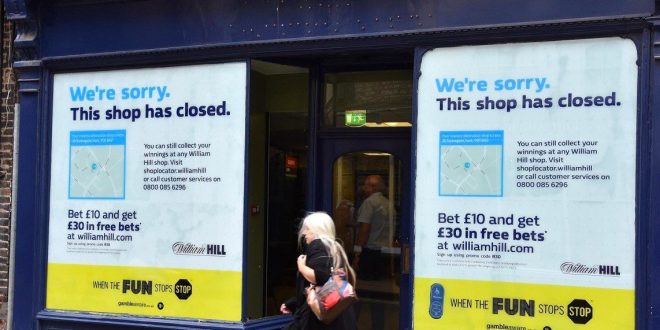Big Four auditor PWC has highlighted the plight of UK betting shops which continue to suffer closures, while their British high street counterparts appear to be experiencing a period of cautious recovery.
The contrast was made clear in the firm’s ‘Industry in Focus Highstreet Report’, which also cited ‘positive signs’ as overall shop closures slow to their lowest levels since 2017.
The recovery, it said, is attributed to a ‘leisure category revival’ and retail chains taking advantage of lower rent venues/locations to open new stores as consumers return to high street shopping.
PWC explained: “The slowdown in store closures continues. In the first six months of this year, a total of 6,147 shops belonging to multiples and chains (those with five or more outlets) exited UK high streets, shopping centres and retail parks – the fewest since 2017.
“Equivalent to 34 closures per day, it’s a significant easing of the rush of closures and administrations we witnessed during the pandemic of 61 per day in H1 2020.”
Returning to normalised trading environments, the report warned that store openings are yet to recover to pre-pandemic levels. So far during 2022, the UK has registered 3,888 stores open (21 per day), significantly below the 5,794 (32 per day) recorded during H1 2017.
Despite an improving picture, high street chains and merchants were reported as being wary of looming economic headwinds (cost of living, inflation), as shop closures hit a seven-year low of 12 net closures per day – “less than half the level seen in 2020 and 2021 (33 and 29 per day respectively)”.
Of significance, 2022 has witnessed a reversal in the volatility of locations chosen by merchants. During 2021, city centres registered significantly more net closures than other areas, feeling the impact of increased working from home and/or hybrid work.
Pandemic factors impacting high street merchants were felt mostly in the urban areas of London and the West Midlands.
The report noted: “While this trend hasn’t quite reversed, there’s been a significant normalisation this time around. There is now a much smaller difference in closures between small towns and big cities (-1.2% to -1.5%) and the spread between regions is the smallest it has been for over seven years.”
Providing a breakdown of shop categories, it was revealed that 23 of 100 categories were net positive for openings, in which leisure-related stores dominated new openings.
The fastest growing net change outlets were attributed to takeaways (+73), DIY shops (+39), amusement arcades (+30), job centres (+17) and restaurants (+17).
Post-pandemic, takeaways have dominated shop openings – a situation helped by changing consumer demands for home delivery and the improved profitability of individual units which have attracted new investment from franchisees and entrepreneurs.
Registered in the top-five highest closures, UK betting shops were categorised as being in a ‘continued structural decline’ standing alongside banks, fashion retailers and charity shops.
However, PWC outlined an easing of betting shop closures during 2022, reporting a net change of 121 store failures in contrast to a nightmare 2021 that registered a net closure of 1,063 outlets.
“The pain may be easing slightly – while net closures remain in the hundreds, they are still not as bad as in previous years,” said PWC. “In H1 2021, we saw over 1,000 fashion retailers close, while this year it was just 128; and in H1 2020, 862 betting shops closed, compared with just 228 this year.”
The report outlined the contrasting fortunes of amusement arcades that are taking advantage of empty high street spaces with low rents.
It said: “They are likely to have benefited from the closure of betting shops, which were as much destinations for their slot machines as they were for sports betting. This will have encouraged new openings, for example, in suburban or seaside towns.”
Though buoyed by a recovery, PWC stated that high street merchants’ outlook for the remainder of 2022 would be shaped by wider economic consequences and government policies to help business
Though shop closures have fallen to a seven-year low, retail footfall remains 10-15% below pre-pandemic levels according to reports by the British Retail Consortium (BRC).
High street merchants outlined ‘big squeeze’ concerns on the cost of living crisis impacting consumer spend and the rising cost of energy/fuel prices on their day-to-day businesses, factors that almost certainly point to an economic recession.
PWC’s report concluded that success is also likely to depend on the focus of a new Prime Minister and how the government intends to help high streets and commit to the levelling up agenda.
Business rates, for instance, will be a critical area for operators, and it will depend on how they are reformed in the near future (if at all).
“While shopping behaviours have changed, the high street has stood the test of time. But it remains in a state of transition and cosmetic interventions alone will not succeed,” it warned.









